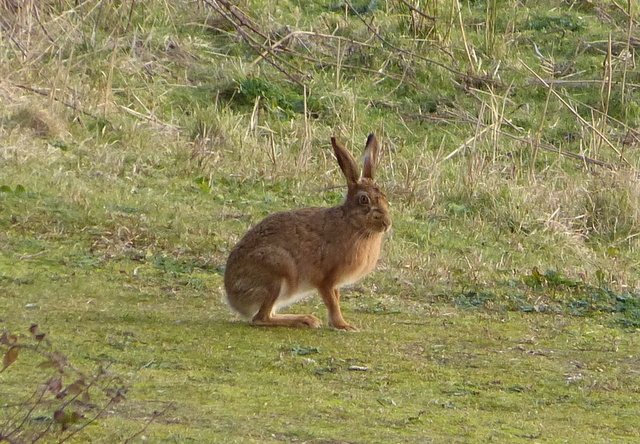A Private Tour in North Norfolk today. It was a gloriously sunny start, if a bit breezy, but it felt like a proper spring day – perfect weather to be out birding.
We started off with a look for Little Owls. At the very first site we tried, we found one perched up in an old oak tree, enjoying the early morning sunshine. The Little Owls have not been here much over the winter, so it was really nice to see one back again. Feeling our luck might be in, we tried a set of barns nearby as well but the resident Little Owls there were not quite so accommodating! Still, it was a great way to start the day.
 Little Owl – enjoying the sunny start to the morning
Little Owl – enjoying the sunny start to the morning
Just around the corner, however, we came across a real commotion in the edge of a field. Two male Grey Partridges were fighting- flapping up in the air with feet out grappling. Then another two appeared – a male and female. The three males proceeded to chase each other across the grass, with the female following. They disappeared up the hill before we could position the car to get some photos, but then yet another pair of Grey Partridge appeared from the hedge. With nobody chasing them, they walked more sedately across the field.
 Grey Partridge – several pairs were squabbling in a field
Grey Partridge – several pairs were squabbling in a field
We made our way over towards Titchwell, stopping en route to watch a little group of Yellowhammers. Out on the reserve, we paused to admire the Marsh Harriers over the reedbed. The Cetti’s Warblers are singing loudly again, but were keeping their heads down as usual.
The water levels on the freshmarsh are still very high (for weed management purposes), though the signs are still promising they will be lowered “next week”. At least the tops of a couple of the islands were starting to show again above the flood and the Avocets had somewhere to stand today. There were several other waders as well – godwits and Redshanks, but they were quite distant from the footpath, easier to see from the hide later.
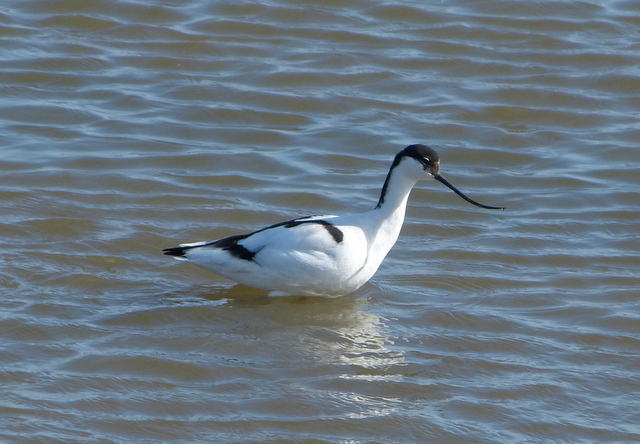 Avocet – great to watch in action, feeding with bills sweeping side to side
Avocet – great to watch in action, feeding with bills sweeping side to side
The ducks were still enjoying the deep water, and there was a good selection – particularly the diving ducks, including Goldeneye, Pochard and Tufted Ducks, plus plenty of dabblers, Teal, Mallard, Gadwall and a couple of Wigeon. The Shoveler perhaps did not appreciate all the water, but there were several out on the shallower tidal pools later on. All the drakes are looking very smart at the moment, but the prize for the smartest goes to the Pintail – we admired the long pin-like tail on a male asleep on the freshmarsh, with tail held aloft.
 Shoveler – a moulting young drake, typically feeding with head under water
Shoveler – a moulting young drake, typically feeding with head under water
Round at the Parrinder Hide, we could get a much better look at the waders on the freshmarsh. There were several Bar-tailed Godwits, as well as the usual Black-taileds, roosting over the high tide on the beach. It was a great opportunity to compare the two – particularly the streakier upperparts versus the plainer grey of the Black-tailed Godwits. A single Ruff fed on one of the emerging islands. A couple of smart Common Snipe were dodging the waves on the bank, very well camouflaged amongst the cut reeds, and one was feeding almost below the hide.
 Snipe – feeding on the bank in front of Parrinder Hide
Snipe – feeding on the bank in front of Parrinder Hide
Out on the Volunteer Marsh, we added a few more waders to the day’s list. A particularly showy Grey Plover performed for the cameras. A couple of Knot were lurking on the edge of the saltmarsh vegetation and a Turnstone was trotting about on the mud.
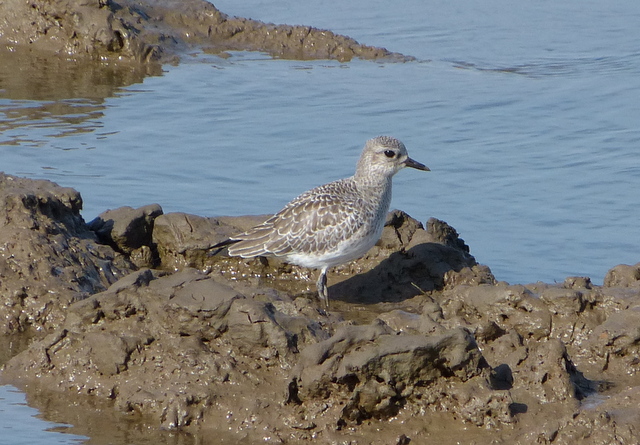 Grey Plover – a particularly showy individual
Grey Plover – a particularly showy individual
From back on the main path, we got great close-up views of a couple of Avocet and four Black-tailed Godwits feeding next to the bank. Up close and personal, we could just see the first orange feathers on one of the godwits, the start of its moult into its bright summer plumage.
 Black-tailed Godwit – a preening bird today, showing well by the path
Black-tailed Godwit – a preening bird today, showing well by the path
And the Volunteer Marsh held lots of Shelduck, looking resplendent in the sunshine.
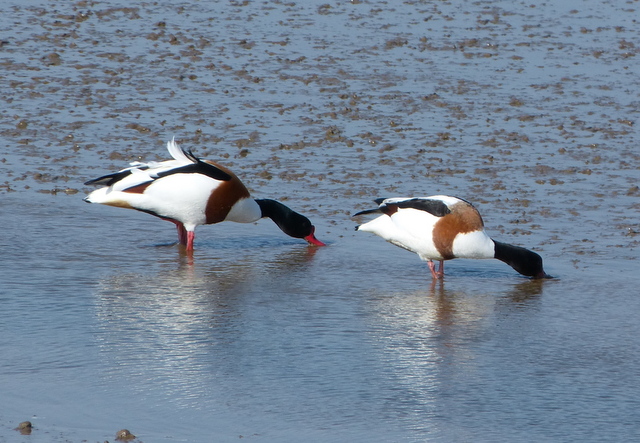 Shelduck (& Sheldrake!) – very smart
Shelduck (& Sheldrake!) – very smart
Just behind the beach, a couple of male Stonechats were feeding around the Suaeda bushes. There have been a lot of Stonechats moving along the coast in the last few days, so presumably these were also on their way somewhere. Several Sanderling were running around on the beach, like clockwork toys. The sea itself was fairly quiet, apart from around a dozen Red-breasted Merganser and a lingering Great Crested Grebe. But scanning offshore revealed a Marsh Harrier flying east quite a way out to sea, presumably a winter visitor on the move, possibly even returning to the continent. Migration in action!
We headed back to the car for lunch. The resident Robins and Blackbirds came begging for scraps and we obliged with a few crumbs. Just as we finished, some soft piping from the bushes just in front of the car revealed a pair of Bullfinches. They sat mutually preening for a few seconds, then returned to attacking the buds of the bushes.
 Bullfinch – a pair were feeding right by the car at lunchtime
Bullfinch – a pair were feeding right by the car at lunchtime
In the afternoon, we drove back east along the coast to Holkham. On the way, we stopped briefly just off the coast road to scan the marshes and immediately latched onto a mass of geese. Amongst the Greylags were a lot of smaller, darker grey geese and a closer look confirmed the continued presence of a wintering group of White-fronted Geese. Looking through the scope, the white feathering around their bill bases caught the sun and we could clearly see the black belly bars of the adults. There were also several Marsh Harriers quartering the marshes and lots of Cormorants in the trees. While we were watching them, a white shape circled round and dropped down behind the trees. Unfortunately, we didn’t all get onto it – a Spoonbill.
Driving along the coast road, another large white shape stood out in the hedge alongside the field opposite the church. A quick stop and we could confirm its identity – a very pale Common Buzzard. This bird is often mistaken for its rarer cousin, the Rough-legged Buzzard. Both are pale birds, but this one had very pale underparts as well as a pale head – a Rough-legged Buzzard from this angle would show a very dark blackish-brown bellow patch (and rough legs!).
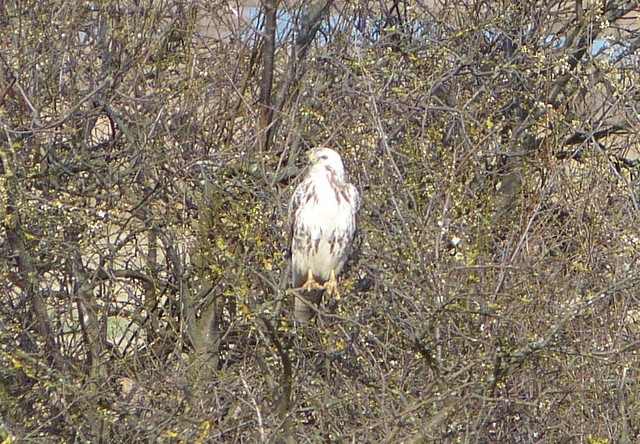 Common Buzzard – a very pale bird, often mistaken for a Rough-legged
Common Buzzard – a very pale bird, often mistaken for a Rough-legged
We parked up at Lady Anne’s Drive and headed west on the inland side of the pines. It was getting quite breezy, but we got some shelter in the trees. There were lots of Goldcrests and tits feeding along the path, and Treecreepers calling from the trees. Just past Meals House, a Chiffchaff was calling from the bushes and perched up briefly. It is about time for our breeding Chiffchaffs to start returning, but this was most likely a bird which had lingered for the winter with one of the local tit flocks.
From Joe Jordan Hide, we could see the Cormorants in the trees and a Red Kite circling towards Burnham Overy. At first, there was no sign of the Spoonbill we had seen from the road, but then two large white shapes flew up from the marshes – their distinctive long necks and black bills held out in front confirmed a couple of Spoonbills. Shortly after, we picked up what was presumably another two birds feeding around one of the pools, swinging their bills from side to side. We got them in the scope and could see their spoon-shaped bills. One Spoonbill stood preening in the wind, its white crest flapping in the breeze. Great to see them back.
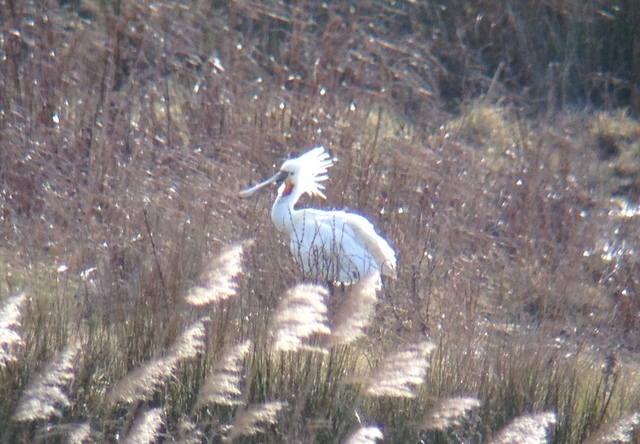 Spoonbill – preening in the breeze, check out that crest!
Spoonbill – preening in the breeze, check out that crest!
We wandered on towards the dunes, stopping to scan from the gate at the end of the pines. The Rough-legged Buzzard was out hovering over the dunes, and we could see its pale head and black belly patch – clearly different from the pale Common Buzzard we had seen earlier. The Rough-legged Buzzard flew out over the grazing marshes and landed on the grass, where we got better scope views of it. It flew up again towards the dunes, and we set off after it in the hope that it might fly overhead. However, it refused to come near us – it flew towards us initially, but turned to hunt over the back of the dunes before heading back out over the marshes.

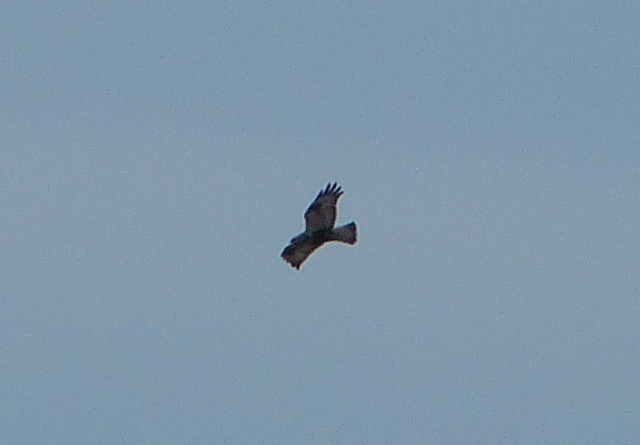 Rough-legged Buzzard – still out on the grazing marshes
Rough-legged Buzzard – still out on the grazing marshes
There were lots of Meadow Pipits out in the grass – at one point a flock of about 50 flew round. Again, though some birds breed and more spend the winter, these were probably migrants which had dropped in to feed in the dunes. Then the Barn Owls appeared – first one, hunting out over the grass, then as we walked back to the pines a second flew out onto the marshes. With the light fading, we decided to call it a day – stopping to admire a smart Brown Hare on the edge of the marsh as we went.
